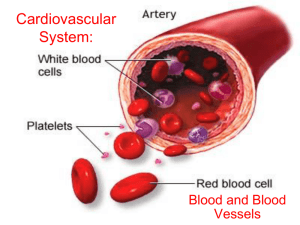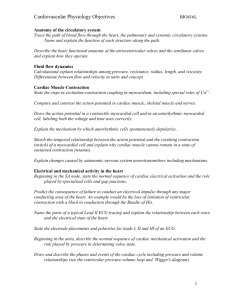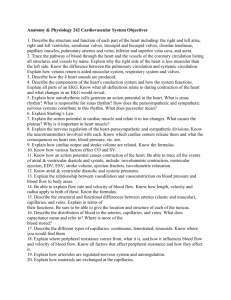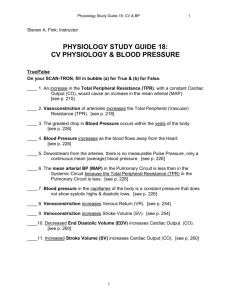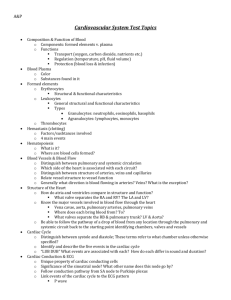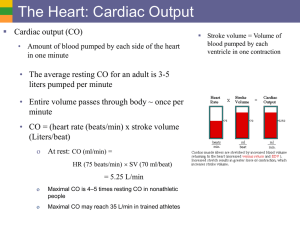Cardiovascular System Blood Pressure
advertisement
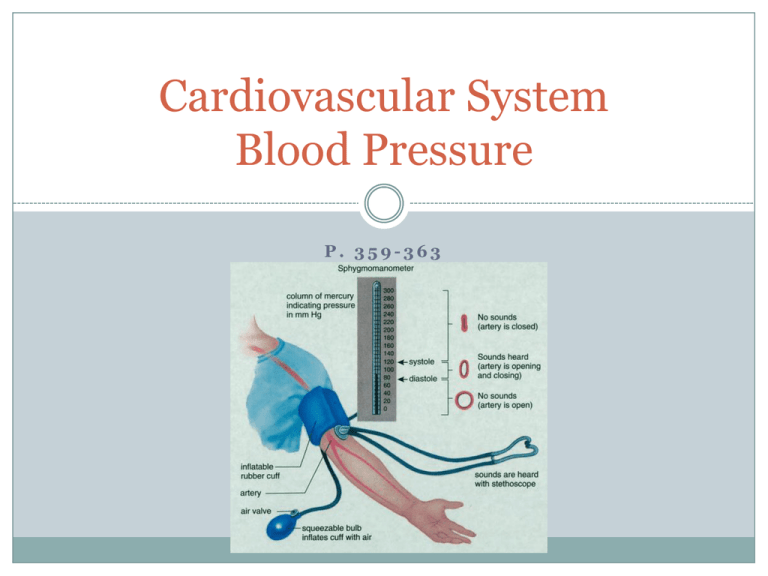
Cardiovascular System Blood Pressure P. 359-363 Blood Pressure Definition: The force blood exerts against the inner walls of blood vessels. Arterial Blood Pressure Rises and falls in a pattern corresponding to phases of cardiac cycle Maximum pressure during ventricular contraction is called systolic pressure When ventricles relax, arterial pressure drops and the lowest pressure is present until the next contraction is called diastolic pressure BP Cont. Example: 120/80 Systolic Pressure Diastolic Pressure Pulse: expanding and recoiling of an artery Factors that influence Arterial BP Heart Action: Determines how much blood enters the arterial system with each ventricular contraction Stroke Volume: Volume of blood discharged from left ventricle; = about 70 mL in an avg. weight male. Cardiac Output: Stroke volume/minute Calculate by multiplying stroke volume by heart rate Example: If S.V. is 70 mL and heart rate is 72, C.O. is 5,040 mL/min. BP varies with C.O.; if S.V. or heart rate increase, C.O rises and so does BP; if S.V. or heart rate decreases, C.O and BP decrease. Blood Volume Varies with age and sex somewhat; directly with body size Avg. blood volume is 5 L. or 8% of body weight B.P. is usually directly proportional to blood volume within cardiovascular system. Example: A hemorrhage would cause blood loss and cause B.P. to decrease. Blood volume also falls if fluid volume is upset like in dehydration. Fluid and blood replacement can restore B.P. and volume. Peripheral Resistance Friction between blood and walls of blood vessels Factors that change P.R. also change B.P. Example: Contraction of smooth muscles in arteriolar walls increase B.P. Dilation of arterioles decrease B.P. Blood Viscosity Ease in which fluid molecules flow past one another. Greater viscosity=greater resistance to flow Blood cells and plasma proteins increase blood viscosity B.P. increases with increased viscosity and decreases with decreased viscosity. Control of B.P. Depends mostly on cardiac output and regulation of peripheral resistance Cardiac output factors: Starlings Law of the Heart: Relationship between myocardial fiber length and force of contraction. Allows heart to maintain a balanced flow of blood. Baroreceptors Found in walls of aorta and carotid arteries, sense changes in B.P. SA Node: Increases or decreases heart blood pressure based off impulse from Medulla Oblongata. Cardiac Output Factors Cont. Cardio-inhibitor Reflex: Happens when heart rate decreases and so does cardiac output and B.P. Returns B.P. back towards normal. Conversely: Decreasing B.P. initiates cardio-accelerator reflex, SA node received impulse and causes heart to beat faster, increasing cardiac output and restoring pressure. Other Factors: Emotional responses such as fear and anger Physical exercise Increase in body temp. Peripheral Resistance Factors Changes in arteriolar diameter Vasomotor center of Medulla sense changes in normal B.P. Can send impulses to increase or decrease P.R. by increasing or decreasing outflow. Certain chemicals CO2, O2, H ions Influence P.R. by affecting capillary sphincters and smooth muscles. Venous Blood Flow B.P. is low by the time it gets to veins that heart action is only a partial result. Results from skeletal muscle contraction, breathing movements, and vasoconstriction of veins. As skeletal muscles contract they push against nearby vessels squeezing blood through vein valves aiding in returning blood back to the heart. Respiration movements move blood through veins by applying pressure in thoracic cavity Vasoconstriction return blood to heart by stimulating smooth muscles to contract during low pressure Veins provide a blood reservoir that adapts to changes in blood volume. If low pressure, vasoconstriction forces extra blood out and to the heart. BP Chart Hypertension: Disease known as high blood pressure Hypotension: Disease known as low blood pressure Review What is the relationship between cardiac output and blood pressure? How does blood volume affect blood pressure? What is the relationship between peripheral resistance and blood pressure? Between blood viscosity and blood pressure? What factors affect cardiac output? What is the function of baroreceptors in the walls of the aorta and carotid artery? How does the vasomotor center control diameters of arterioles?
